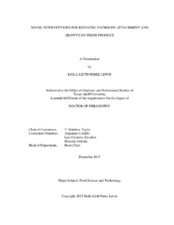| dc.description.abstract | The objectives of this research were to 1) identify the native microbiota on surfaces of fresh fruit and leafy greens; 2) identify microorganisms antagonistic towards Salmonella enterica Typhimurium LT2 and Escherichia coli O157:H7 ATCC 700728 both in vitro and on produce surfaces; and 3) evaluate the ability of antimicrobial-bearing nano-encapsulates to prevent pathogen attachment and growth on produce surfaces. Produce (cantaloupe, tomato, endive, and spinach) was sampled from two farms for each produce type (n=30). Aerobic bacteria, lactic acid bacteria (LAB), yeasts/molds, enterococci, and coliforms were enumerated using appropriate media. For each sample, 4-12 isolated colonies from each medium were submitted to biochemical identification. Antagonism of recovered isolates against pathogens was determined using the Agar Spot method. Produce was spot-inoculated with a suspension of bacteria showing in-vitro antagonistic activity against S. enterica Typhimurium LT2 and E. coli O157:H7 then stored at 25°C for 24 h. Each sample was spot-inoculated with a suspension including both pathogens and stored at 25°C. At 0, 6, 12, and 24 h of storage, loose and strong attachment of pathogens on the surface was determined. Geraniol-loaded NPs were prepared by flash nanoprecipitation. Inhibition of Escherichia coli O157:H7 and S. Typhimurium LT2 was tested in vitro and on produce at 5°C, 15°C, and 25°C for up to 10 days. The organisms isolated from the surface of the various produce commodities were diverse; 1,389 isolates were isolated from the surfaces of cantaloupes, tomatoes, spinach, and endive. Of these, 109 (7.8%) showed antagonism activity in vitro against S. Typhimurium LT2 and 91 (6.6%) against E. coli O157:H7. Staphylococcus antagonistic isolates showed larger zones of inhibition against both pathogens than the other antagonistic isolates recovered from produce. On produce surfaces, the endive-recovered isolate Escherichia coli and the cantaloupe-recovered isolated Escherichia hermannii depressed the growth of both pathogens. Geraniol loaded NPs inhibited S. Typhimurium and E. coli O157:H7 growth at 0.4 and 0.2 wt.%, respectively. Pathogen reductions on treated produce ranged from 1.2 to 6.0 log10 CFU/cm^2. In summary, antimicrobial NPs and microorganisms naturally present on produce may be useful for the post-harvest decontamination of fresh produce, from cross-contaminating microbial pathogens. | en |


